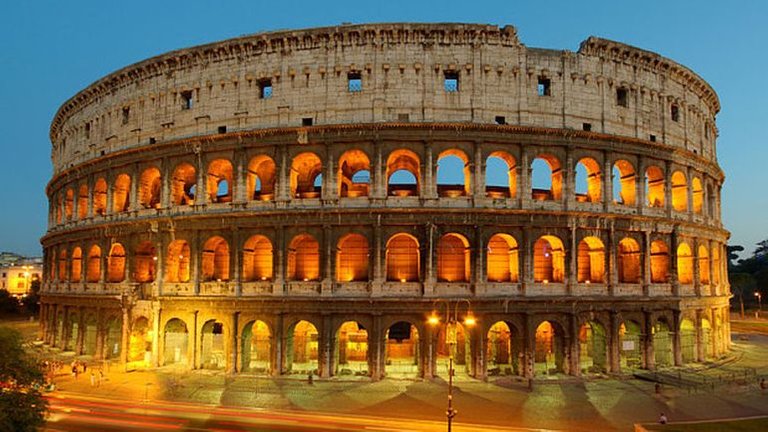Rome’s great gladiatorial arena is the most thrilling of the city's ancient sights. Inaugurated in AD 80, the 50,000-seat Colosseum, also known as the Flavian Amphitheatre, was clad in travertine and covered by a huge canvas awning held aloft by 240 masts. Inside, tiered seating encircled the arena, itself built over an underground complex (the hypogeum) where animals were caged and stage sets prepared. Games involved gladiators fighting wild animals or each other.
The emperor Vespasian (r AD 69–79) originally commissioned the amphitheatre in AD 72 in the grounds of Nero's vast Domus Aurea complex. But he never lived to see it finished and it was completed by his son and successor Titus (r 79–81) a year after his death. To mark its inauguration, Titus held games that lasted 100 days and nights, during which some 5000 animals were slaughtered. Trajan (r 98–117) later topped this, holding a marathon 117-day killing spree involving 9000 gladiators and 10,000 animals.
The arena was originally named after Vespasian's family (Flavian), and although it was Rome’s most fearsome arena, it wasn’t the biggest – the Circo Massimo could hold up to 250,000 people. The name Colosseum, when introduced in medieval times, was not a reference to its size but to the Colosso di Nerone, a giant statue of Nero that stood nearby.
The outer walls have three levels of arches, framed by decorative columns topped by capitals of the Ionic (at the bottom), Doric and Corinthian (at the top) orders. They were originally covered in travertine and marble statues filled the niches on the 2nd and 3rd storeys. The upper level, punctuated with windows and slender Corinthian pilasters, had supports for the masts that held the awning over the arena, shielding the spectators from sun and rain. The 80 entrance arches, known as vomitoria, allowed the spectators to enter and be seated in a matter of minutes.
The Colosseum's interior was divided into three parts: the arena, cavea and podium. The arena had a wooden floor covered in sand to prevent the combatants from slipping and to soak up the blood. Trapdoors led down to the underground chambers and passageways beneath the arena floor – the hypogeum. Animals in cages and sets for the various battles were hoisted up to the arena by 80 winch-operated lifts. The cavea, for spectator seating, was divided into three tiers: magistrates and senior officials sat in the lowest tier, wealthy citizens in the middle and the plebs in the highest tier. Women (except for vestal virgins) were relegated to the cheapest sections at the top. The podium, a broad terrace in front of the tiers of seats, was reserved for emperors, senators and VIPs.

With the fall of the Roman Empire in the 5th century, the Colosseum was abandoned. In the Middle Ages it became a fortress occupied by the powerful Frangipani family. Later, it was plundered of its precious travertine, and marble stripped from it was used to decorate notable buildings such as Palazzo Venezia, Palazzo Barberini and Palazzo Cancelleria.
More recently, pollution and vibrations caused by traffic and the metro have taken a toll. To help counter this, it was recently given a major clean-up, the first in its 2000-year history, as part of an ongoing €25-million restoration project sponsored by the luxury shoemaker Tod's.
The top three tiers (known collectively as the Belvedere) and hypogeum are open to the public by guided tour only. Visits, which cost €9 on top of the normal Colosseum ticket, require advance booking.
Hi! I am a robot. I just upvoted you! I found similar content that readers might be interested in:
https://www.lonelyplanet.com/italy/rome/attractions/colosseum/a/poi-sig/1160430/359975
Congratulations @tallgerado! You have completed some achievement on Steemit and have been rewarded with new badge(s) :
Click on any badge to view your own Board of Honor on SteemitBoard.
For more information about SteemitBoard, click here
If you no longer want to receive notifications, reply to this comment with the word
STOP